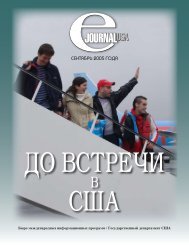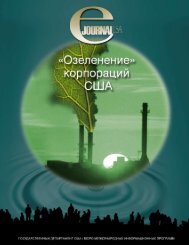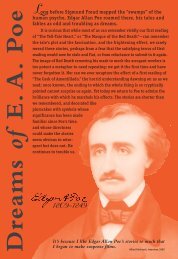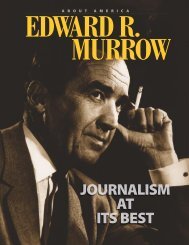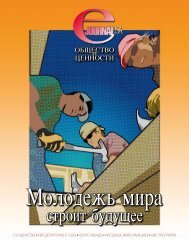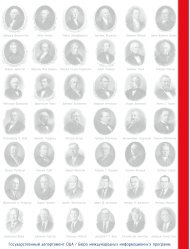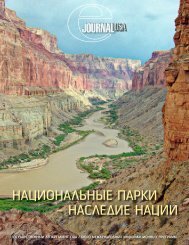AMERICAN
Outline of American Literature
Outline of American Literature
- No tags were found...
You also want an ePaper? Increase the reach of your titles
YUMPU automatically turns print PDFs into web optimized ePapers that Google loves.
the quiet poverty, loneliness, and despair in<br />
small-town America.<br />
THE “CHICAGO SCHOOL” OF POETRY<br />
hree Midwestern poets who grew up in<br />
Illinois and shared the midwestern concern<br />
with ordinary people are Carl Sandburg,<br />
Vachel Lindsay, and Edgar Lee Masters. Their<br />
poetry often concerns obscure individuals; they<br />
developed techniques — realism, dramatic renderings<br />
— that reached out to a larger readership.<br />
They are part of the Midwestern, or Chicago<br />
School, that arose before World War I to challenge<br />
the East Coast literary establishment. The<br />
“Chicago Renaissance” was a watershed in<br />
American culture: It demonstrated that America’s<br />
interior had matured.<br />
T<br />
Edgar Lee Masters (1868-1950)<br />
By the turn of the century, Chicago had become<br />
a great city, home of innovative architecture and<br />
cosmopolitan art collections. Chicago was also<br />
the home of Harriet Monroe’s Poetry, the most<br />
important literary magazine of the day.<br />
Among the intriguing contemporary poets the<br />
journal printed was Edgar Lee Masters, author<br />
of the daring Spoon River Anthology (1915),<br />
with its new “unpoetic” colloquial style, frank<br />
presentation of sex, critical view of village life,<br />
and intensely imagined inner lives of ordinary<br />
people.<br />
Spoon River Anthology is a collection of portraits<br />
presented as colloquial epitaphs (words<br />
found inscribed on gravestones) summing up the<br />
lives of individual villagers as if in their own<br />
words. It presents a panorama of a country village<br />
through its cemetery: 250 people buried<br />
there speak, revealing their deepest secrets.<br />
Many of the people are related; members of<br />
about 20 families speak of their failures and<br />
dreams in free-verse monologues that are surprisingly<br />
modern.<br />
Carl Sandburg (1878-1967)<br />
A friend once said, “Trying to write briefly<br />
about Carl Sandburg is like trying to picture the<br />
Grand Canyon in one black-and-white snapshot.”<br />
Poet, historian, biographer, novelist, musician,<br />
essayist — Sandburg, son of a railroad blacksmith,<br />
was all of these and more. A journalist by<br />
profession, he wrote a massive biography of<br />
Abraham Lincoln that is one of the classic works<br />
of the 20th century.<br />
To many, Sandburg was a latter-day Walt<br />
Whitman, writing expansive, evocative urban and<br />
patriotic poems and simple, childlike rhymes and<br />
ballads. He traveled about reciting and recording<br />
his poetry, in a lilting, mellifluously toned voice<br />
that was a kind of singing. At heart he was totally<br />
unassuming, notwithstanding his national fame.<br />
What he wanted from life, he once said, was “to<br />
be out of jail...to eat regular..to get what I write<br />
printed,...a little love at home and a little nice<br />
affection hither and yon over the American landscape,...(and)<br />
to sing every day.”<br />
A fine example of his themes and his<br />
Whitmanesque style is the poem “Chicago”<br />
(1914):<br />
Hog Butcher for the World,<br />
Tool Maker, Stacker of Wheat,<br />
Player with Railroads and the<br />
Nation’s Freight Handler;<br />
Stormy, husky, brawling,<br />
City of the Big Shoulders...<br />
Vachel Lindsay (1879-1931)<br />
Vachel Lindsay was a celebrant of small-town<br />
midwestern populism and creator of strong,<br />
rhythmic poetry designed to be declaimed aloud.<br />
His work forms a curious link between the popular,<br />
or folk, forms of poetry, such as Christian<br />
gospel songs and vaudeville (popular theater) on<br />
the one hand, and advanced modernist poetics<br />
on the other. An extremely popular public reader<br />
in his day, Lindsay’s readings prefigure “Beat”<br />
56




